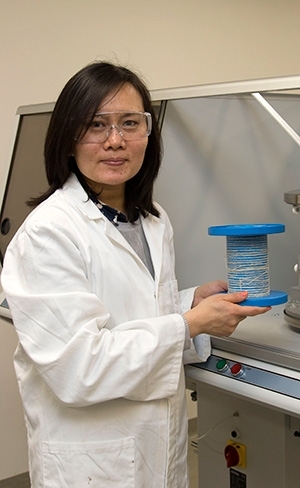Smart cotton to protect us from airwaves blitz
Research news
The digital “wearables” revolution is upon us, from smart phones, to wearable health trackers, to smartwatches.
Deakin Research Fellow Dr Jin Zhang is using her own smart materials know-how to develop a new way to protect humans from the electromagnetic radiation emitted by wearable gadgets – in case they pose a risk to our long-term health.
Based in Deakin’s Institute for Frontier Materials (IFM), Dr Zhang recently received a three-year grant from the Cotton Research and Development Corporation to combine the strengths of lightweight carbon fibre and quality Australian cotton to create a “super smart” shielding fabric.
She and her team will focus on developing a process to fully enclose carbon fibre within cotton, through the IFM’s sophisticated fibre processing machines. If successful, the process will be a world first, with huge commercial potential.
“Carbon fibre is effective as an electromagnetic shielding material because of its intrinsic conductivity,” Dr Zhang explained.
“It shields in a similar way to metal, but, unlike metal, our material would still be light and comfortable to wear. It could also be used to create shielding bedding, curtains, groundsheets or tents, which could be used for defence, medical or other purposes.”
Dr Zhang has been a research pioneer in the field of carbon fibre composites. Since joining Deakin for her PhD study 13 years ago, she has worked on areas ranging from lightweight and multifunctional composites, to “self-healing” thermosets, to playing a key role in research and development projects for the rapid curing carbon fibre “Quickstep Process.”
Over the past two years, she has also received prestigious Victoria and Endeavour Fellowships for her foundational work exploring the properties of silk cocoons, as a basis for creating lightweight materials for personal protection, load-bearing and energy-absorbing purposes.
“Our air waves are filling up with wireless, radio and digital transmissions - for FM and AM radio, internet connections, cell phones, radar and microwave systems, remotes, smart wearables and local area networks,” Dr Zhang said.
“As more electronic devices emerge, the usable range of electromagnetic waves is shifting to higher frequency regions. Research is suggesting that these higher frequencies and shorter wavelengths may pose a health risk, particularly from devices that we carry on our body.”
She added that there was a “pressing need to control and shield sensitive electronic equipment, such as instruments used in defence or medical applications, from these kinds of emissions.”
“There is also a growing call from the public for shielding, with particular concern about the effects of electromagnetic fields on biological devices, such as pacemakers,” she said.
“Although there is a lack of long-term data about electromagnetic effects on human health, increased awareness of electromagnetic interference has led to new regulations around the globe for electrical and electronic equipment manufacturers to comply with.
“While these guidelines help to protect the public from the effects of electromagnetic radiation, the shielding fabric will provide greater protection from the sources that are closer to the body.”
If the project is successful, the new fabric will provide high protection from electrostatic discharge, electromagnetic radiation, radio frequency interference (through the carbon fibre), combined with the hypoallergenic, moisture control and comfort of Australian cotton.
With some groundwork already complete, Dr Zhang is optimistic that she will achieve her goal within three years. After that, she believes there will be no shortage of commercial interest in her “super” fabric.
Share this story
 On the trail of a 'super' fabric - Dr Jin Zhang.
On the trail of a 'super' fabric - Dr Jin Zhang.
